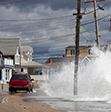Adaptation Overview
Many governments and organizations across the United States and the world are already adapting to climate change. This is important because we are already seeing the impacts of climate change – including sea level rise, changing precipitation patterns, and more frequent incidences of heat waves and other extreme weather events. Many impacts are expected to grow in geographic scale, rate, or intensity as global temperatures continue to increase.
Individuals, organizations, and communities can take many steps to adapt to a changing climate – and to help plants and animals cope as well.
Adaptation actions can be:
- Reactive: responding to conditions that have already changed.
- Anticipatory: planning for climate change before impacts have occurred.
Examples of Adaptation
Adaptation measures are already in place in many areas, as the examples below show. These actions can be expanded or modified to prepare for climate change. But additional measures, such as new technologies and policies, may also be needed. Such actions could require time and resources to carry out, so planning now is important.
Agriculture and Food Supply

- Develop crop varieties that are more tolerant of heat, drought, or flooding from heavy rains.
- Provide more shade and air flow in barns to protect livestock from higher summer temperatures.
Coasts

- Preserve wetlands and open spaces to protect coastal communities from flooding and erosion from storms and sea level rise.
- Improve evacuation planning for low-lying areas to prepare for increased storm surge and flooding.
Ecosystems

- Protect and expand wildlife habitats to allow species to migrate as the climate changes.
- Reduce pollution, habitat loss, and other stressors that make ecosystems more vulnerable to climate change.
Energy

- Increase energy efficiency to help offset rises in energy consumption, such as from more air conditioning use as temperatures warm.
- Strengthen energy production facilities to withstand increased flood, wind, lightning, and other storm-related stresses.
Human Health

- Set up early warning systems and emergency response plans to prepare for more extreme weather events.
- Educate people to help them avoid diseases that could become more prevalent as the climate changes, such as those carried by mosquitoes or ticks.
- Plant trees and expand green spaces in cities to reduce the "urban heat island" effect.
Water Resources

- Improve water use efficiency, and build additional water storage capacity.
- Protect and restore stream and river banks to provide wildlife habitat and safeguard water resources.
Key Adaptation Terms
Adaptation – Adjustment in natural or human systems to a new or changing environment that takes advantage of beneficial opportunities or moderates negative effects.
Adaptive capacity – The ability of a system to adjust to climate change (including climate variability and extremes) to moderate potential damages, take advantage of opportunities, or cope with the consequences.
Resilience – A capability to anticipate, prepare for, respond to, and recover from significant threats with minimum damage to social well-being, the economy, and the environment.
Vulnerability – The degree to which a system is susceptible to, or unable to cope with, adverse effects of climate change, including climate variability and extremes. Vulnerability is a function of the character, magnitude, and rate of climate variation to which a system is exposed, its sensitivity, and its adaptive capacity.
Source: National Research Council, 2010. Adapting to the Impacts of Climate Change.
